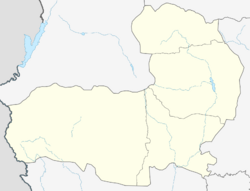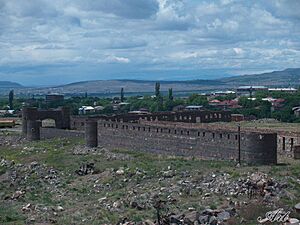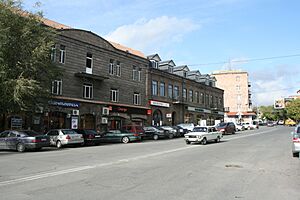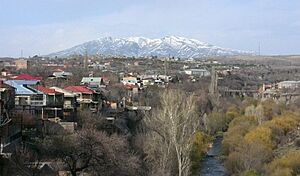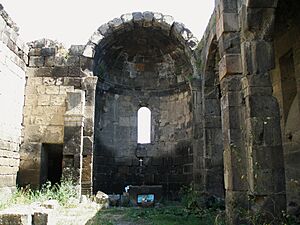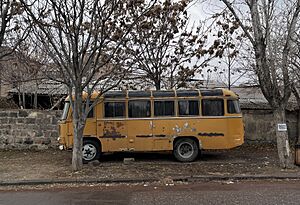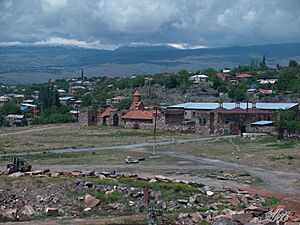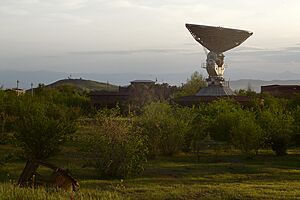Ashtarak facts for kids
Quick facts for kids
Ashtarak
Աշտարակ
|
|||
|---|---|---|---|

From top left:
Ashtarak town • Ashtarak bridge of 1664 Karmravor Church • Saint Marianeh Church • Surp Sarkis Church House-museum of Perch Proshyan • the statue of Nerses Ashtaraketsi |
|||
|
|||
| Country | Armenia | ||
| Province | Aragatsotn | ||
| Municipality | Ashtarak | ||
| First mentioned | 9th century | ||
| City status | 1963 | ||
| Area | |||
| • Total | 7.5 km2 (2.9 sq mi) | ||
| Elevation | 1,110 m (3,640 ft) | ||
| Population
(2011 census)
|
|||
| • Total | 18,834 | ||
| • Density | 2,511/km2 (6,500/sq mi) | ||
| Time zone | UTC+4 (AMT) | ||
| Postal code |
0201-0205
|
||
| Area code(s) | (+374) 232 | ||
| Sources: Population | |||
Ashtarak (Armenian: Աշտարակ) is a town in the Aragatsotn Province of Armenia. It is located on the left side of the Kasagh River gorge, about 20 kilometers (12 miles) northwest of the capital city, Yerevan. Ashtarak is the main center of its province and an important meeting point for roads connecting Yerevan, Gyumri, and Vanadzor.
The town is very important for Armenia's economy and culture. It has many factories and cultural places. Ashtarak has grown to be a "satellite town" of Yerevan, meaning it's a smaller town close to a big city that depends on it. The nearby village of Mughni is also part of the Ashtarak area.
In 2011, about 18,834 people lived in Ashtarak. By 2016, the number was estimated to be around 18,000. Ashtarak is also home to the main office of the Armenian Apostolic Church for the Aragatsotn region.
Contents
Etymology (Meaning of the Name)
The name Ashtarak comes from the Armenian language word for tower or fortress. Some people think the name might be linked to an ancient goddess of fertility named Ishtar. However, newer studies show that the name Ishtar was not used in ancient Armenian stories. Instead, the goddess of fertility was called Shardi or Sardi in the old kingdom of Urartu, and later Astghik by Armenian monks.
Other ideas suggest the name Ashtarak might be connected to a legendary Armenian figure named Shidar, or to Sarduri II, a king of Urartu.
History
Early Times and Middle Ages
Very old burial sites from the Bronze Age have been found near modern Ashtarak. Experts believe these were built by an ancient Indo-European group, possibly early Armenians.
According to an old Armenian historian, Movses Khorenatsi, the family of Hayk, who founded the Armenian nation, settled in the area where Ashtarak is today.
Historically, the area of Ashtarak was part of the Aragatsotn region in the ancient Kingdom of Armenia. Ashtarak is one of the oldest places in Armenia. It has many old buildings and monuments that show the special style of Armenian architecture.
Ashtarak was first mentioned as a village in the 9th century. However, its importance decreased in the centuries that followed because different foreign powers ruled the area. Between the 11th and 15th centuries, the Aragatsotn region and other parts of Armenia faced invasions from the Seljuks, Mongols, Ag Qoyunlu, and Kara Koyunlu.
Modern History
In the early 1500s, Ashtarak became part of the Persian Safavid Empire. In the 1600s, the town was completely rebuilt. Later, in the 1700s, Ashtarak was part of the Erivan Khanate, ruled by different Persian dynasties.
Ashtarak was the site of a battle in August 1827 during the Russo-Persian War. Persia won this battle. The town remained under Persian rule until 1827-1828. After this war, Eastern Armenia, including Ashtarak, became part of the Russian Empire through the Treaty of Turkmenchay.
After the Russian Empire ended in 1917, Ashtarak became part of the First Republic of Armenia, which was declared on May 28, 1918. But after two years, Armenia joined the Soviet Union in December 1920. From 1930 to 1995, Ashtarak was the center of the Ashtarak region. In 1963, Ashtarak was officially given the status of a town.
When Armenia became independent again in 1991, Ashtarak became the capital of the new Aragatsotn Province in 1995.
Geography
Ashtarak is located on the left bank of the Kasagh River, about 13 kilometers (8 miles) northwest of Yerevan. It is about 1110 meters (3,642 feet) above sea level.
The town is located between the Ararat plain to the south and the Aragats mountains to the north. The area has many water sources. The fountains of Saghmosavan, Nazrevan, and Shroshor provide drinking water for the town.
Ashtarak is divided into four parts: Old Ashtarak (on the right bank of the Kasagh river), Dzakhap (meaning left bank), Gitavan, and Bagavan. The village of Mughni is also part of the Ashtarak area. The valley of Ashtarak, known as Ashtaraki dzor, is a popular place for visitors from Yerevan and nearby towns.
Climate
Ashtarak has a climate with hot, dry summers and cold winters. The hottest and driest months are usually August and September. Spring is the wettest time of the year.
Demographics
| Historical population | ||
|---|---|---|
| Year | Pop. | ±% p.a. |
| 1831 | 826 | — |
| 1891 | 2,550 | +1.90% |
| 1914 | 4,867 | +2.85% |
| 1926 | 4,853 | −0.02% |
| 1959 | 7,563 | +1.35% |
| 1972 | 13,900 | +4.79% |
| 2001 | 18,915 | +1.07% |
Culture
Ashtarak has a cultural center, four art schools, and many public libraries. One important library is the Aragatsotn regional library, named after Vardges Petrosyan. The town is also home to the house-museum of the writer Perch Proshyan, which opened in 1948 in his family home. It was last fixed up in 2008.
The 17th-century bridge of Ashtarak over the Kasagh River is one of the town's interesting sights. It is in the gorge below the Saint Sarkis Church. A rich merchant named Mahdesi Khoja Grigor built it in 1664. The bridge has three arches that are different in size.
Historical Monuments
There is a legend about three sisters who lived in Ashtarak. All of them fell in love with the same man, Prince Sarkis. The two older sisters decided to give up their lives for the youngest one. One sister wore an apricot-orange dress, and the other wore a red dress. They both jumped into the Ashtarak gorge. When the youngest sister found out, she put on a white dress and also jumped into the gorge. After this, Sarkis became a hermit (someone who lives alone for religious reasons). Three small churches appeared at the edge of the gorge, named after the colors of the sisters' dresses.
The best-preserved of these three churches is the Karmravor Church (meaning reddish because of its dome color). It dates back to the 7th century and is dedicated to the Holy Mother of God. It is a small church with a cross shape and a reddish/apricot-colored dome. Other churches include Tsiranavor (meaning apricot-colored), from the 5th century, and Spitakavor (meaning whitish), from the 13th century. Both are located along the edge of the gorge.
Saint Marianeh Church
The biggest church in town is the Saint Marianeh Church, located in the center of Ashtarak. It was built in 1271. It has a rectangular shape from the outside and a cross shape inside, with an eight-sided dome. A bell tower was added in 1838.
Saint Sarkis Church
The 19th-century church of Surp Sarkis was built on an old foundation. It stands on a beautiful spot overlooking the gorge and offers a great view of the three churches mentioned earlier. The outside walls of the church were recently repaired, but the inside walls are still original. Some carved pieces from the old outer walls can still be seen next to the church.
Ashtarak Walnut Festival
The Ashtarak Walnut Festival happens every year in October. It celebrates the famous and tasty walnuts from Ashtarak. The festival started in 2012 and is organized by the French-Armenian owners of a local café called Pascal & Diodato.
Transportation
Ashtarak is connected to Yerevan by the Ashtarak highway. The M-1 Motorway links Ashtarak with northwestern Armenia, including the city of Gyumri. The M-3 Motorway connects the town with northeastern Armenia, all the way to the Georgian border.
You can find taxi services in Ashtarak. Also, public vans, known as marshrutka, travel regularly between Ashtarak and Yerevan throughout the day.
Economy
Ashtarak is an important industrial center in Aragatsotn Province. The town's industries mainly focus on processing food, making dairy products, and producing drinks. They mostly use local ingredients like grapes.
Ashtarak is home to "Ashtarak-Kat" (founded in 1995), a leading company in Armenia that makes ice cream and dairy products. The town also has the "Gourmet Dourme" chocolate factory (founded in 2007), "P & D Group Armenia" which makes plastic containers (founded in 2007), and the "Milen Art" plant and "Kharam Cooperative" which produce building materials.
The valley of the Kasagh river, known as Ashtaraki dzor, is a popular place for visitors from Yerevan and other areas. It has many restaurants and places to relax.
Education
Ashtarak has 7 public schools and 6 kindergartens for young children. It also has the Ashtarak State Vocational School, which is a technical college.
Two important scientific research centers in Armenia are located in Ashtarak:
- Institute of Radiophysics and Electronics: This institute was founded in 1960. It does research and development in areas like radio engineering, automatic control, and physics.
- Mikael Ter-Mikaelian Institute for Physical Research: Founded in 1967, this organization studies physics, including laser physics and material science.
Sport
FC Mika was a football club created in 1999 by combining two clubs: Mika Ashtarak and Kasagh Ashtarak. The new club was called Mika-Kasagh Ashtarak. However, this combination only lasted for one year, until 2000. Kasagh Ashtarak went back to its original name, while FC Mika became a new club. In 2007, Mika moved from Ashtarak to Yerevan. The only stadium in the city is Kasaghi Marzik Stadium, which can hold 3,500 people.
The sport school in Ashtarak is run by the Sevan sports organization. The center was completely renovated and opened in July 2017. It cost about 1 million US dollars. The school has about 350 young athletes who train in sports like Olympic wrestling, weightlifting, boxing, martial arts, volleyball, basketball, football, and chess.
Ashtarak is also home to the "Ayrudzi" horse racing club.
International Relations
Twin Towns – Sister Cities
Ashtarak has a "twin town" relationship with:
 Alfortville, France (since 1993).
Alfortville, France (since 1993).
Notable People
- Nerses V Ashtaraketsi (1770–1857), a very important leader of the Armenian Church.
- Perch Proshyan (1837–1907), a famous novelist.
- Smbat Shahaziz (1840–1908), a poet.
- Norair Sisakian (1907–1966), a Soviet Armenian biochemist and one of the founders of space biology.
- Gevorg Emin (1918–1998), a poet.
- Emil Gabrielian (1931-2010), an Armenian physician.
- Vardges Petrosyan (1932–1994), a playwright and novelist.
- Vazgen Muradian (1921-2018), a composer.
See also
 In Spanish: Ashtarak para niños
In Spanish: Ashtarak para niños




